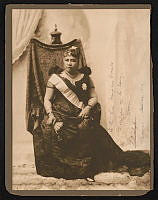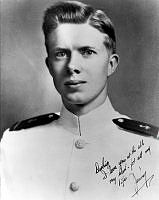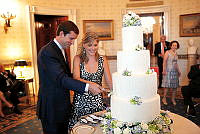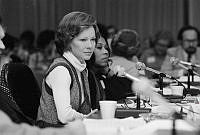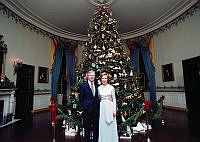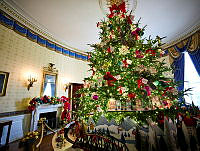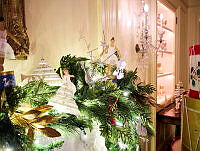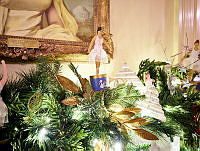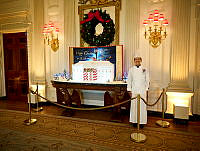Rubenstein Center Scholarship
Women's Groups and First Ladies' Portraits
Portraits have long served the purpose of connecting contemporary audiences to people of the past. Portraits not only depict the appearance of their subjects and the fashions of the time, but they provide insights about the artists and those who commissioned them. At the end of the nineteenth century, several women’s groups engaged in all steps of the process of commissioning a portrait by fundraising, selecting, and paying an artist to paint first ladies who were members or representatives of their group. These women’s groups then donated the commissioned portrait of their respective first lady to the White House, though this was somewhat uncommon for the time. Portraits of first ladies were often commissioned by the first family or other private citizens, and only later were they regularly acquired for the White House. Although today’s White House Collection includes many portraits of first ladies, this was not always the case. In the late 1860s, following the Civil War, former First Lady Julia Tyler proposed to President Andrew Johnson the idea of a portrait collection of the wives of presidents.1 She also donated an 1848 portrait of herself by artist Francesco Anelli to the White House as the first piece in the first lady collection.2

Portrait of First Lady Julia Gardiner Tyler completed by Francesco Anelli in 1848.
White House Historical Association/White House CollectionThe contribution of first ladies’ portraits to the White House Collection coincided with other changes that gripped America after the Civil War as the country transitioned into the Gilded Age, a period of rapid industrialization, economic change, and urbanization. Among the many changes that characterized the Gilded Age, more women pursued new opportunities in education, work, and politics, and sought greater change in society.
One popular group of women who sought social change during this period was the Woman’s Christian Temperance Union (WCTU).3 The WCTU was founded in Cleveland, Ohio in November of 1874 to seek reform against alcohol abuse.4 In 1879, Frances Willard became the national president of WCTU and introduced a “do everything” approach, expanding the social reform efforts of the organization beyond the limitation of alcohol sales and consumption to other goals such as increasing the age of consent and fighting the sale of tobacco to children.5
In 1877, the issue of temperance and the efforts of the WCTU took center stage as President Rutherford B. Hayes and his wife Lucy Hayes entered the White House. Lucy’s support of the temperance movement was well known and after wine was served at their first White House event, a reception for Grand Duke Alexis of Russia, the president and first lady announced that they would no longer serve any alcohol in the White House.6 Lucy’s support of the temperance movement resulted in the nickname “Lemonade Lucy.” This title was used mockingly in limited instances during her lifetime but later came to be associated with her through historians’ repeated use of the alliterative moniker.7 Despite such criticism, Lucy’s support of temperance did not waver and resulted in the WCTU’s celebration of Lucy as a representative of their cause on both a local and national scale. The Mrs. R.B. Hayes Temperance Society of the District of Columbia was founded in Lucy’s name and WCTU national president Frances Willard applauded Lucy’s steadfast support of temperance in her role as first lady during an 1880 address at a Lake Bluff, Illinois temperance camp titled “Mrs. Hayes and Total Abstinence at the White House.”8
To further solidify Lucy as an icon of the temperance movement and elevate the standing of the organization, the Woman’s Christian Temperance Union committed to commissioning a portrait of the first lady for the White House in 1880. The effort to memorialize Lucy’s stand against alcohol during her time in the White House was first proposed by a local temperance delegation in Delaware, Ohio, and then grew on a national scale.9 Donations were sent for the portrait, and if fundraising exceeded the portrait cost, for a temperance literature fund.10 Language surrounding the call for donations reveals that for members of the WCTU, it was an honor to contribute to the portrait. One newspaper report on the fundraising effort read “That all may have opportunity to share in it, subscriptions as low as ten cents will be received.”11 Those who donated five dollars or more could also share in the celebration, receiving an engraving of the portrait.12

Portrait of First Lady Lucy Webb Hayes commissioned by the Woman’s Christian Temperance Union. Completed by Daniel Huntington in 1881.
White House Historical Association/White House CollectionThe full-length portrait of Lucy Hayes, completed by famous New York portrait artist Daniel Huntington, in 1881, cost three thousand dollars.13 Lucy chose Huntington, who at the time was the president of the National Academy of Design, to paint her WCTU commissioned portrait. He went on to paint President Hayes’ portrait in 1884.14 Lucy’s portrait was the first to be commissioned for the express purpose of being added to the growing collection of first lady portraits - an additional honor for Lucy, who as first lady had tried to collect portraits of all former presidents for the White House.15 On the evening of March 7, 1881, the WCTU unveiled the completed portrait at a ceremony at Lincoln Hall.16 The following morning, a delegation of WCTU members presented the portrait at the White House to the recently inaugurated President James A. Garfield and First Lady Lucretia Garfield.17
Just over a decade later, another prominent women’s group commissioned Daniel Huntington to produce an official portrait of a first lady: The National Society Daughters of the American Revolution and their first president general, First Lady Caroline Harrison.
Spurred by an increase in nationalist sentiment and the centennial celebration of the Inauguration of President George Washington, the National Society Daughters of the American Revolution (DAR) was founded on October 11, 1890.18 The organization aimed to inspire the remembrance and celebration of the history of the American Revolution, to educate and enlighten the public in line with the ideals laid out by President George Washington in his Farewell Address, and to foster patriotic spirit.19 To achieve these goals, the DAR asked First Lady Caroline Harrison to serve as the first president general, as her participation would bring immediate prestige and prominence to the new organization.20 Although she delegated many of the day-to-day duties of the president general to the vice president presiding, Mary Virginia Ellet Cabell, Caroline spoke at the First Continental Congress for the society in February 1892 and hosted a reception in the East Room of the White House for nearly one hundred DAR delegates on the evening of February 24, 1892.21
Caroline served as president general of the DAR until she passed away on October 25, 1892, from tuberculosis. Immediately following her death, to honor her leadership, the DAR sent a resolution of all Caroline’s services during her time as president general and a floral design of the group’s insignia to President Benjamin Harrison.22 To further memorialize their former leader, the DAR used donations from every chapter to commission Daniel Huntington to paint a portrait of Caroline Harrison for the White House.23
The DAR unveiled Huntington’s painting of Caroline at the Third Continental Congress in Washington, D.C. on February 22, 1894, prior to its delivery to the White House.24 Not only did the DAR solidify its standing in American society by having the first lady serve as their first president general, but they also reinforced the DAR’s presence in the White House by having Huntington depict Caroline wearing the DAR badge, which is positioned over her heart in the portrait. Caroline’s leadership in the DAR remains an important piece of both the first lady’s and the organization’s legacy, and a copy of the Huntington portrait still hangs in the President General’s Reception room at the DAR National Headquarters.25

Portrait of First Lady Caroline Harrison commissioned by the Daughters of the American Revolution. Completed by Daniel Huntington in 1894.
White House Historical Association/White House CollectionMuch like Caroline Harrison’s lasting place of prominence within the history of the DAR, First Lady Grace Coolidge remains a celebrated member of the sorority, Pi Beta Phi. Sororities formed in the late nineteenth and early twentieth centuries to support women as they navigated the male-dominated world of higher education. The boom of sororities coincided with the transition from the Gilded Age to the Progressive Era, during which time ideas of social reform and woman’s role in society continued to garner mainstream attention.26 The sorority that came to be known as Pi Beta Phi was first founded in 1867, and in 1888, the name officially changed from I.C. Sorosis to Pi Beta Phi.27
Unlike the aforementioned first ladies who represented the groups that donated their portraits during their tenure as first lady, Grace Coolidge was a member of Pi Beta Phi during her time at the University of Vermont.28 After her graduation in 1902, Grace remained an active alumna member of the sorority, and Pi Beta Phi celebrated their former member when she moved into the White House.29
To mark the occasion and highlight her lifelong membership to Pi Beta Phi, the sorority commissioned a portrait of the first lady completed by artist Howard Chandler Christy. The sorority aimed for the honor of commissioning Grace’s portrait to be felt organization wide, remarking, “The Grand Council feels certain that every Pi Beta Phi will want to have a part in this tangible expression of the fraternity’s pride in and affection for Mrs. Coolidge who has ever been a most loyal and actively interested member.”30 Letters published in the June 1924 edition of Pi Beta Phi’s publication, The Arrow, reported that chapters across the country were eager to donate to the fund for the commissioned portrait. The issue also advertised that following the presentation, photographs of the portrait could be purchased by any member for two dollars.31
The Grand President of Pi Beta Phi, Amy B. Onken, presented the portrait to First Lady Grace Coolidge at the White House on April 11, 1924, during the sorority’s Eastern Conference, held in Washington, D.C.32 Grace attended the event in the East Room of the White House, greeted the hundreds of ceremony guests, and posed for pictures on the White House North Lawn.33

First Lady Grace Coolidge (center right with no hat) with members of the Vermont Beta chapter of Pi Beta Phi, during their visit for the portrait presentation on April 11, 1924.
Howard Chandler Christy’s portrait depicted Grace in a vibrant red dress with her white Collie, Rob Roy, on the South Lawn of the White House. Like Caroline Harrison’s portrait, Grace is pictured wearing her Pi Beta Phi badge over her heart, an ever-present reminder of the sorority’s honor that remains tied to the White House. Since 1952, the portrait of First Lady Grace Coolidge has frequently hung in the White House China Room, where it remains today.

Portrait of First Lady Grace Coolidge commissioned by Pi Beta Phi. Completed by Howard Chandler Christy in 1924.
White House Historical Association/White House CollectionOfficial portraits commissioned by women’s groups are just one way that first ladies’ commitment to their respective groups is memorialized in White House history, as evident by the official portraits of Lucy Hayes, Caroline Harrison, and Grace Coolidge. As the twentieth century progressed more first ladies continued to serve as representatives for various women’s groups, often elevating the organizations’ platforms, service objectives, and philanthropic efforts. Members of the women’s groups that first ladies represented and belonged to became frequent visitors to the White House to celebrate and discuss their shared causes. As the role of first lady grew more robust, so too did the honor of having a first lady serve as a representative of an organization.













